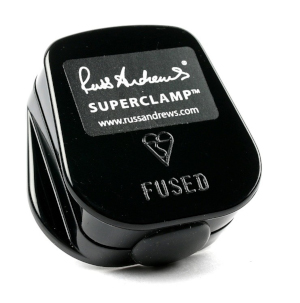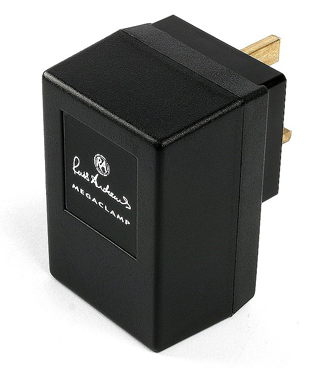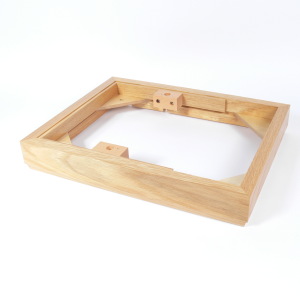SuperClamps and MegaClamps
Tuesday, 12th January 2021
We’ve two families of clamping products: SuperClamps and MegaClamps. But what are they and what do they do? John Armer investigates.
Click here to skip to details about SuperClamp, and here for details of MegaClamp.
Spikes can vary between just a few tens of volts above the highest legal peak voltage, and up to several thousand volts; most of them last under a millisecond and they tend to go unnoticed. Because they are short in duration, the energy involved tends to be small - just a few joules - but a high rate of spike activity - a ‘train’ of spikes - can cause problems. Even with well-designed equipment, regular spikes or transients can prematurely stress and wear-out critical mains-connected parts and their insulation.
Our SuperClamps and MegaClamps are designed to grab or ‘clamp’ these spikes and reduce the effect they have on our Hi-Fi systems.
What causes spikes?
Most obviously, spikes are caused by lightning strikes, but there are many other causes - power cuts; circuit breakers operating; faulty equipment; light switches being turned on and off; fridges, freezers, dishwashers, washing machines and central heating thermostats switching on and off; electric motors operating… the list is extensive.
Why are spikes of particular concern to Hi-Fi?
Along with Radio Frequency Interference, Russ identified mains spikes as being a problem for Hi-Fi systems back in the 1970s. Aside from the issue of the premature wear of components, he became aware of the increase in the quality of sound when he fitted devices to reduce spike activity. It seemed that spikes were increasing the noise floor and distortion in the music signal, and when these were removed there was a subjective increase in the sound quality. He set about a period of research and development to design a product that would be effective at reducing spikes without any negatives and the resulting product - Clamp1 - was one of the first products he launched in the early 1980s. Today, the range still includes a refined and improved version of that first product - the SuperClamp.
What makes good spike protection?
Clearly, it’s important that a good spike protector must reduce and absorb the high voltage caused by spikes, meaning that a more stable voltage, within range, is available. But it’s also important that it should do this without compromising other areas of the music. The design of our clamps means that they are undetectable in the absence of spike activity. They are parallel devices that do not interrupt the mains supply - they do not raise the dynamic impedance of the mains supply like some inline devices do - our tests have shown that inline devices can make the music sound ‘flatter’, less dynamic and less musical.
What are the differences?
We have two families of clamps - SuperClamp and MegaClamp. SuperClamps give effective basic protection and we recommend replacement after five years to maintain their effectiveness. Available as a stand-alone plug in device, we can also build them into many of our mains products, such as mains extensions, filters and PowerKords. MegaClamps are much more powerful devices which have the benefit of not needing replacement every five years or so. Available as stand-alone devices, they can also be built into some of our mains filters and our Signature PowerBlock.
SuperClamp
 Technology
TechnologySuperClamp consists of two components: a very fast solid state device culled from aerospace application to grab spikes, and a varistor to absorb the spike energy.
Application
In its simplest form, the components are mounted in a plug top which is simply plugged into an empty socket close to your Hi-Fi system. Multiple SuperClamp Plugs can be used throughout the home for additional benefits. Nothing needs to be connected to the SuperClamp Plug for it to work.
SuperCubes are also available which mount the SuperClamp components in a two-way cube adaptor: useful if you are running out of sockets.
SuperClamps are also supplied as standard in our Silencer, MiniPurifier and Power Purifier mains filters, and our X-Block mains extensions. They are also an optional extra in the PowerBar mains extension, and in any of our mains cables fitted with a WattGate IEC plug. In all these products, the SuperClamp components are fitted internally.
Finally, SuperClamp kits are available for DIYers wishing to fit the components themselves to e.g. amplifiers or CD players or behind mains sockets. They must be soldered and instructions are provided.
CLICK HERE TO BUY SUPERCLAMP
CLICK HERE TO BUY SUPERCUBE
CLICK HERE TO BUY SUPERCLAMP KIT
MegaClamp

Technology
MegaClamps use components originally developed for the communications industry and are far more effective at absorbing spike energy than anything we have tested before. Unlike the SuperClamp, they do not wear out over time.
Application
MegaClamps are available mounted in a ‘wall-wart’ plug top. Like the SuperClamp Plugs, they are designed to plug in close to your Hi-Fi - a spare socket in its mains extension is ideal. Nothing needs to be connected to the MegaClamp Plug for it to work.
2-way MegaCubes are also available.
MegaClamps are fitted as standard to our top-of-the-range Signature PowerBlock, and they are also available as an option on our Mini Purifier and PowerPurifier mains filters.
“Greater bass definition, more open mid and high range on a quieter background - subtle but nontheless there.”
Z Nikolov. Online Customer Review
CLICK HERE TO BUY MEGACLAMP
CLICK HERE TO BUY MAGACUBE
SuperClamp Ultra & MegaClamp Ultra
Technology
The ‘Ultra’ versions of Super- and MegaClamps use multiple SuperClamp and MegaClamp components for ultimate performance. Additionally, they employ a special clamping component to reduce spike activity on the earth.
Application
SuperClamp Ultra and MegaClamp Ultra are only available as stand-alone ‘wall-wart’ plug tops. They are designed to be used close to your system - a spare socket in the mains extension feeding your Hi-Fi system is ideal.
“Quiet background with the music becoming much clearer.”
A. Saltmarsh. Online Customer Review of the SuperClamp Ultra
“Highly effective clamp.”
S. Hipkiss. Online Customer Review of the MegaClamp Ultra
CLICK HERE TO BUY SUPERCLAMP ULTRA
CLICK HERE TO BUY MEGACLAMP ULTRA
Written By John Armer






















